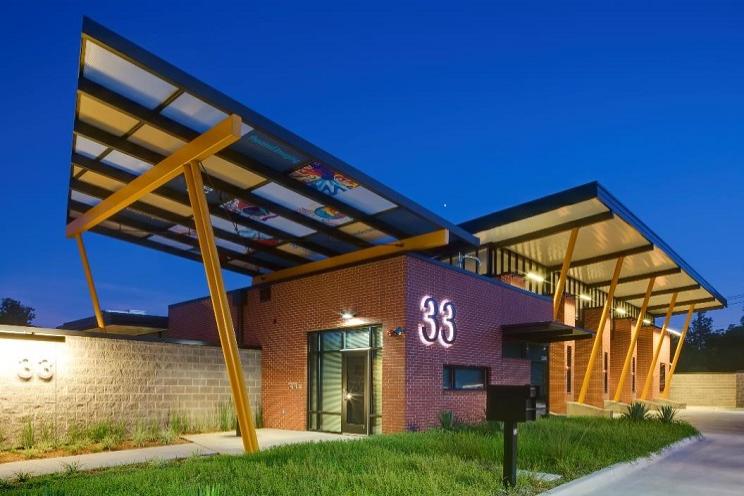image: Firestation 33 – BRW Achitects
“As the landscape of the city evolves, our department must also evolve to reflect those changes.”
There’s nothing overly grand about Dallas Fire-Rescue Chief Louie Bright III’s reflection on his department and the city it serves. It’s a simple statement of approach, delivered at the opening of the new Firehouse 37, and the circumstances that make the approach necessary, but to me it captures the moment we live in in a way nothing else quite has. Dallas’ Fire and Rescue Department is evolving, and just like the city itself it’s doing it at a remarkable pace, and-just like Dallas itself- not just aesthetically, but functionally. Dallas as a city isn’t just a few destinations anymore; suddenly we have neighborhoods that are more than just areas with names. From West Dallas to East you can find thriving blocks of restaurants, bars, coffee houses, venues, and shops in lovingly renovated developments that sit comfortably alongside contemporary construction projects. This is the key to the distinct personalities that have emerged to burnish the names of areas that used to just be mentioned for the sake of location. As a city we’ve taken on the model of rejuvenating heritage structures and filling in the gaps with distinctive buildings of our own time, and this is just as true for the new fire stations as it is for any of the mixed-use developments that are popping up across the metroplex.
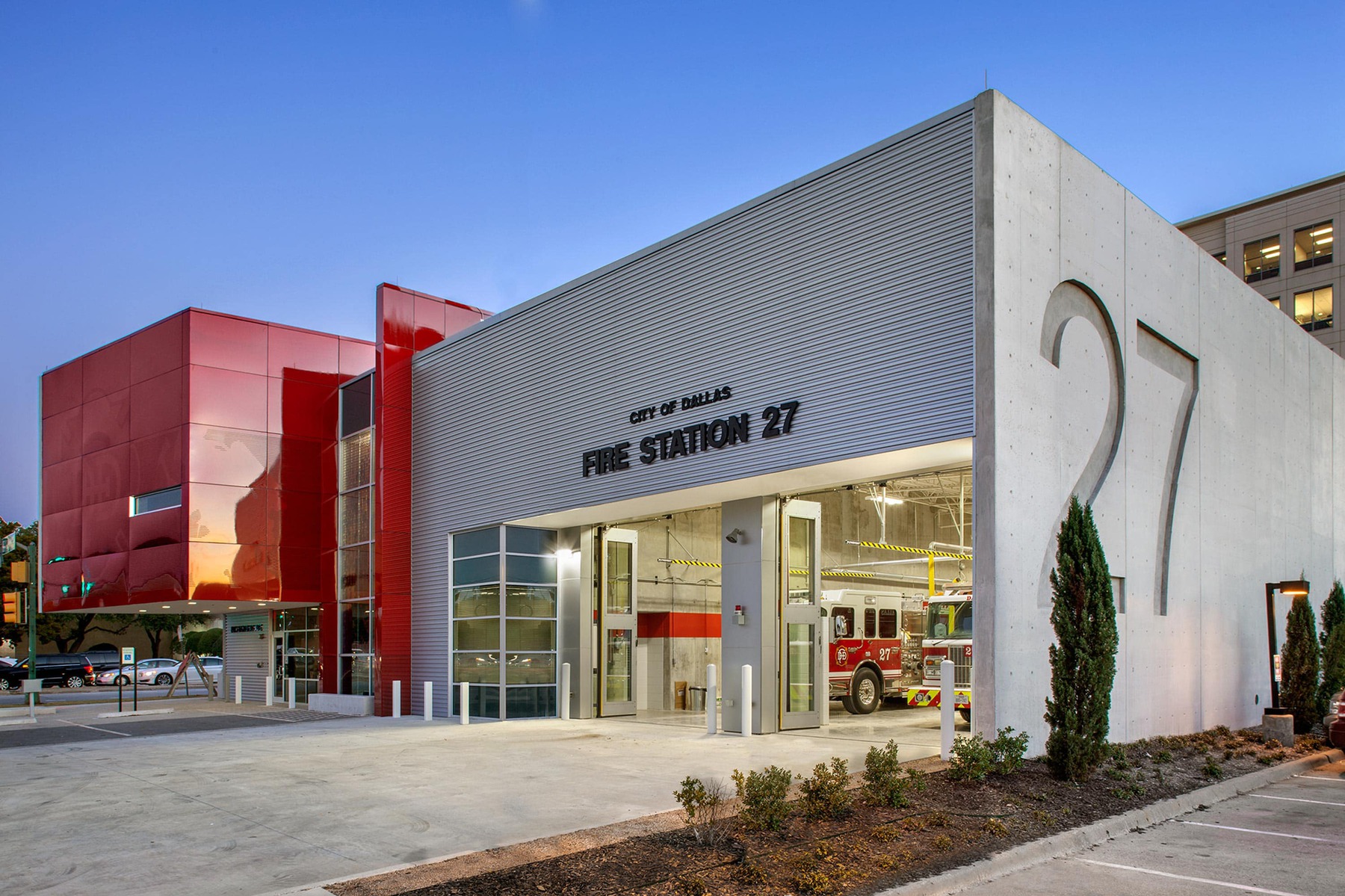
The Dallas Morning News declared that Fire Station 37, located on Greenville Avenue, “heralds northeast Dallas revival.” That’s a lot for one building to shoulder, and not without reason. The new station, designed by Dewberry, replaced the original, 60-year-old structure. Like the other fire stations featured in this article, Fire Station 37 is a LEED-Gold certified, carbon neutral building with the added benefits of solar water-heating and geothermal heating and cooling systems, but the most impressive feature of this facility is the door system. Most fire stations have bay doors that open by either flipping or rolling upwards. Fire Station 37 was designed with a Four-Fold Door System. Brian Meade, one of the designers for Dewberry on the project, explained “we always start with these in our design budgets since they help reduce response time for the fire trucks to get out. They open in half the time as traditional sectional doors.”
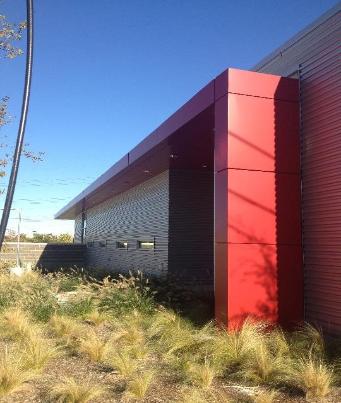
It’s something that might not occur (hadn’t, clearly) to most people, but prescient strategy in service of the firefighters to help them do their jobs is just as important to these architects as the visual impact of the structure- though clearly visual impact is a concern as well. The building is unmistakably a structure built for today. It has a robust industrial presence highlighted with a life-instilling and eye-catching border of red that Meade describes as “a symbolic, natural choice” to accentuate the shape and levels of the building. The design certainly isn’t shy, and it’s easy to see how it could “herald” the revival of northeast Dallas. This is a building that stands in sharp contrast to its surroundings, but as a symbol of reinvestment in the community it also proposes itself as a model of what will likely come in its wake.
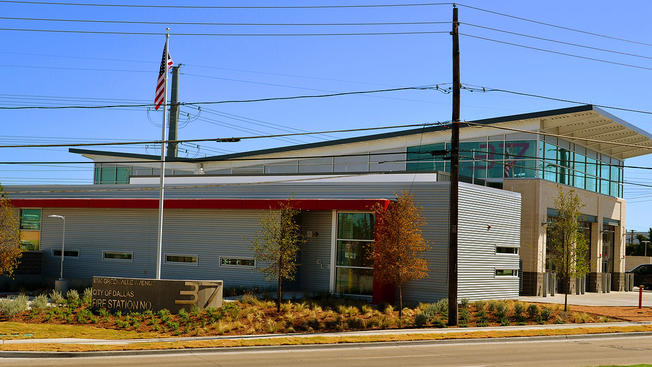
Fire Station 33 is located on West Illinois Avenue, in between South Hampton and I-35, in the heart of Oak Cliff. Anyone that has been to one of Dallas’ best examples of a neighborhood revival knows that Oak Cliff is largely made up of heritage structures that have been standing for generations. Most of its residents have put considerable effort into restoring and giving new life to the modestly-sized Tudors that are the hallmark of the area. Bearing this in mind, it’s both sensitive and clever of BRW Architects, the firm behind Fire Station 33, to simply refresh the brick, bunker-like design that most of the older fire stations in Dallas have in order to more comfortably nestle the new station into its surroundings. It’s not a contrarian structure, defiantly exulting a style all its own, but anyone that would call it a “compromise” and consider that a slight is missing out on the subtlety and surprises that meet your gaze as you approach it. The awning that shields you as you approach the entrance reveals itself as a colorful collage of images-lit from above by the very sun it’s protecting you from. As with Fire Station 37, Fire Station 33 improves on its green bonafides by adding an ample clerestory of windows to act as a natural -light welcoming crown for the building. Less need for artificial light equals less energy expended, but, as BRW Architects’ website romantically intones, when artificial light becomes necessary in the evenings the windows “glow… as a symbol of protection for the community.” The idea of the station itself being an entity of safety isn’t so far-fetched. A fire station is much more active, with more moving parts, than your average building, and the designs of these new stations reflect that. Fire Station 33 might look inert and straight-laced were it not for the columns-done in a much needed splash of joyful yellow-that, rather than standing vertically, are angled to project outwards to give a sense of spreading over the area that nicely compliments the protective glow the building casts at night.
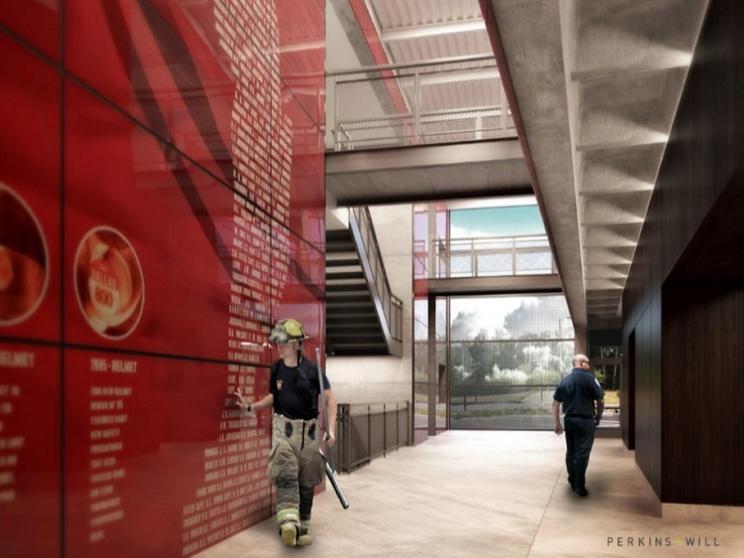
Fire Station 27 is the first multi-story fire station to be built in Dallas in 100 years (Fire Station 11 on Cedar Springs was built in 1909, and the fire station that is now the Dallas Firefighters Museum was built in 1907), and not because of ego, but necessity. It’s officially a two-story structure, but as Ron Stelmarski of Perkins+Will, the design firm behind Fire Station 27, pointed out “Really it’s a three story building with the underground parking.” Still under construction, and very close to completion, on Northwest Highway it boasts a potential LEED Platinum certification and a sophisticated layout that has more than tripled the square footage of the original station. Perkins+Will had a very tight footprint to work with, and have more than made the most of it. A “stacked” apparatus bay design helps by compartmentalizing the focus of each area and floor- this allows the western half of the street-level floor to be devoted to the fire engines, which can pass through either the front or the back of the structure which improves both response time and reduces the impact on traffic flow. Obviously, as Stelmarski remarked, “You don’t want to clog up Northwest Highway,” and he and the other designers at Perkins+Will found a way to make the entrance and exit transition more gentle, and the pass-through design possible, by rotating the structure 90 degrees. It’s a brilliant example of economy that also gives the area a thrilling, significant new addition to its architectural landscape.
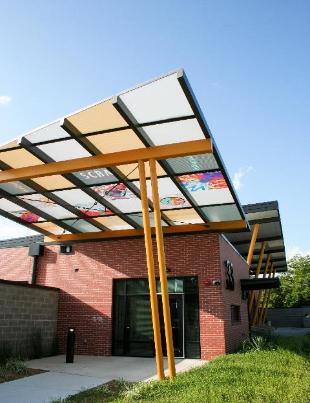
Fire is an uneasy force to live with. It can ravage acres of trees and pastureland, but afterwards the scorched remains of the plants create remarkably fertile soil for the regeneration of everything it took away. It has allowed us to keep warm, find our way in the dark, forge tools, fly, and in one form or another it provides the energy we need to generate electricity. The same qualities of loss and rebirth and innovation are just as much a part of gentrification and development. These fire stations are perhaps the best examples of how Dallas is coping with its new identity. Their overall look is a reflection of the areas they occupy, but the structures themselves are all made for a more efficiently managed future- especially in terms of making sure that the fire department can attend to the growing needs of the community. “Dallas is on fire right now” is a pretty common phrase going around town. We’re reshaping ourselves, and others are reshaping us as well, in that fire, and despite losses sustained and those that have yet to come to pass it’s all working towards a better Dallas: more navigable, more alive, and more safe thanks to the careful planning of multiple design firms and the initiative of the Dallas Fire Department and Dallas itself.
resources:
// brwarch.com
// dewberry.com
// perkinswill.com
authored by J. Claiborne Bowdon

